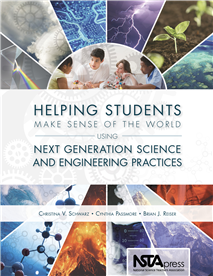All Book Chapters
Book Chapter
The first part of this chapter explains the importance of the two practices that include elements designed to address the different goals and outcomes of engineering. The latter part of the chapter, shares a classroom case that illustrates the entir...
Book Chapter
This chapter is about fostering what we call academically productive talk in science classrooms to support students’ engagement with the eight science and engineering practices. We first introduce a picture of the most common varieties of classroom...
Book Chapter
Throughout the chapters, we have provided many vivid images of students who are learning science in meaningful ways. In this chapter, we provide guidance about how these goals can be accomplished, using two examples. From the two units we’ve descri...
Book Chapter
This chapter concludes our discussion of the science and engineering practices with a summary of the big ideas from the book and a few strategies. We revisit some important ideas about science and engineering practices we hope you have developed, wea...
Book Chapter
Big Data, Small Devices: Investigating the Natural World Using Real-Time Data (Book Sample)
Now your students can transform their mobile phones and tablets into tools for learning about everything from weather to water quality. Big Data, Small Devices shows you how. This book is designed for Earth and environmental science teachers who want...
Book Chapter
In this lesson, students will explore the relationship between tropospheric ozone and temperature and how human populations affect ozone levels. Disciplinary core ideas covered are weather and climate and human impacts on Earth systems. Tips for scal...
Book Chapter
In this lesson, students will use mean (average) temperature data to determine changes in surface temperature over time in different areas of Earth. Disciplinary core ideas covered are Earth’s systems and weather and climate. Tips for scaling down,...
Book Chapter
In this lesson, students will use a National Oceanic and Atmospheric Administration (NOAA) database to identify extreme weather events throughout the United States in different locations or over time. Disciplinary core ideas covered are Earth’s sys...
Book Chapter
In this lesson, students will use weather data to create a current weather map by drawing station models for multiple locations. Disciplinary core ideas covered are Earth materials and systems and weather and climate. Tips for scaling down, scaling u...
Book Chapter
In this lesson, students will develop and analyze meteograms for select cities to construct a 24-hour history for a specific location. Disciplinary core ideas covered are Earth materials and systems and weather and climate. Tips for scaling down, sca...
Book Chapter
In this lesson, students will use flight take-off and landing patterns to better understand wind. Disciplinary core ideas covered are Earth materials and systems and weather and climate. Tips for scaling down, scaling up, and extending the lesson are...
Book Chapter
In this lesson, students will come to understand the range and frequency of behaviors in which animals can engage, and how those might be affected by factors such as weather conditions or time. Disciplinary core ideas covered are natural resources an...
Book Chapter
In this lesson, students will compare population dynamics in emerging and developed nations, including how those populations use natural resources. Disciplinary core ideas covered are Earth and human activity and natural resources. Tips for scaling d...
Book Chapter
In this lesson, students will explore long-term trends in land use using data from the U.S. Department of Agriculture (USDA). Disciplinary core ideas covered are natural resources and human impacts on Earth systems. Tips for scaling down, scaling up,...
Book Chapter
In this lesson, students will determine whether there is a correlation between drought and wildfires using data from two states. Disciplinary core ideas covered are the roles of water in Earth’s surface processes and natural hazards. Tips for scali...



